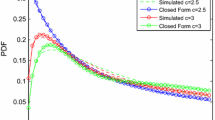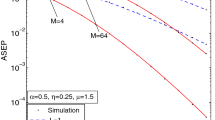Abstract
In wireless communication systems, the received signal is superimposed by the contemporaneous effects of both shadowing and multipath fading. The conventional composite models fail to capture the outliers in the fading channels. In this context, we portray the significance of the Tsallis’ non-extensive parameter ‘q’ in modeling various fading environments. This paper exploits the well-known q-Weibull probability density function (pdf) in characterizing the composite fading channels. The q-Weibull pdf yields a tight agreement over the generated fading signals. Furthermore, the different performance metrics, viz. amount of fading, average channel capacity, and outage probability, are obtained in closed form. The derived results are validated using rigorous Monte Carlo simulation procedure.
Access provided by Autonomous University of Puebla. Download conference paper PDF
Similar content being viewed by others
Keywords
1 Introduction
In real-life propagation scenarios, the wireless communication channels get simultaneously impaired by shadowing and multipath fading. This phenomena in wireless communication systems leads to a composite fading environment [1,2,3]. Several models have been propounded to characterize the multipath fading phenomena, viz. Rician, Rayleigh, Weibull, and Nakagami, whereas shadowing is modeled using distributions such as the Inverse Gamma, Gamma, and Lognormal [1, 3]. These distributions can be superimposed to characterize the contemporaneous effects of both shadowing and fading. For this purpose, different composite models, viz. the Weibull-lognormal (WL), Nakagami-lognormal, and Rayleigh-lognormal [4,5,6,7], have been suggested. However, the lognormal-based mixture models are mathematically intractable which requires several approximations techniques to obtain the desired results. In contrast, the entropy-based approach characterizes the various fading channels in continuous range of Tsallis’ non-extensive parameter ‘q’.
It is worth noting that the Weibull distribution [1, 4, 8, 9] is best suited to model multipath fading channels and its proficiency can be extended by introducing the Tsallis’ non-extensive parameter ‘q’ [10, 11]. The q-Weibull distribution [12] can characterize both multipath and shadowing effects simultaneously by varying the continuous interval of non-extensive parameter ‘q’. In contrast to the conventional composite models, for \(q>1\) this model has a long-tailed behavior which provides a better fit to the tail fluctuations in the fading signals [13].
In this paper, the importance of q-Weibull distribution [12] is portrayed to characterize the composite fading scenarios. The different performance metrics, viz. the outage probability \((P_{out})\), average channel capacity, and amount of fading (AOF), are expressed in closed form. It is observed that the results obtained are analytically tractable and the obtained measures are found to be in close agreement with the Monte Carlo simulation results.
The remaining paper proceeds as follows: Section 2 illustrates the q-Weibull distribution. Section 3 portrays the importance of q-Weibull model in contrast to the well-known Weibull-lognormal distribution in capturing composite fading environments. The numerical and simulation results for the performance measures have been discussed in Sect. 4. Finally, Sect. 5 provides the conclusion and future works.
2 The q-Weibull Distribution
The pdf of q-Weibull distribution can be defined as [12]:
where \(\alpha >0\) is the fading parameter, \(\lambda >0\) represents the scale parameter, and \(\gamma \) is the received signal-to-noise ratio (SNR). When \(q\rightarrow 1\), Eq. 1 converges to the well-known Weibull distribution. Furthermore, for q>1 the q-Weibull distribution follows a long-tailed behavior which enables it to smoothly characterize the tail fluctuations in the fading signals.
From Fig. 1, it is observed that as q approaches 2, the phenomena of long-tailed distributions are obtained and similarly as \(q\rightarrow 1\), the curve becomes peaked and mimics the Weibull distribution.
3 Significance of q-Weibull Model
It is well known that shadowing effects are characterized by lognormal distribution [1, 3]. However, the conventionally used lognormal-based composite models, viz. Rayleigh-lognormal, WL models are inefficacious in characterizing the tail fluctuations in the fading signals [13]. In Fig.2, it is observed that the well-known WL model [4, 5] fails to provide a better fit to the synthetic fading signals. The fading signals are generated using MATLAB to mimic the real-time fading scenarios. However, it is possible that the entropy-based q-Weibull distribution can characterize the entire outliers in the fading channels. In this context, the q-Weibull model provides a better fit to the outliers in the fading signals for \(1<q<2\). The generated fading signals are well characterized by the q-Weibull distribution corresponding to \(q=1.3\) as shown in Fig. 3.
4 Numerical Results and Discussions
In this section, various performance metrics in wireless communications systems, viz. average channel capacity, amount of fading, outage probability in correspondence to the q-Weibull model, have been illustrated. Furthermore, the obtained measures are found to be in closed agreement with the simulation results (Fig. 4).
4.1 Amount of Fading
In wireless fading scenarios, the amount of fading (AOF) is an important performance metric as it specifies the severity of fading and is given as [4, 5]:
The rth moment of \(\gamma \) is obtained as:
or,
From Eqs. (2) and (4), analytical expression for AOF is given as:
4.2 Average Channel Capacity
It is an important performance metric that defines the maximum transmission rate a channel achieves with a small probability of error. In ergodic sense, the average channel capacity is expressed as [5, 14]:
where B denotes the bandwidth of the fading channel. Equation(1) and Eq.(6) yield:
As Eq. (7) is not analytically tractable, using Meijer’s G approximations of the polynomials [15]; \(\ln (1 + \gamma ) = \mathop G\nolimits _{22}^{12} \left[ {\gamma \left| {_{1,0}^{1,1}} \right. } \right] \) and \(\exp ( - \gamma ) = \mathop G\nolimits _{01}^{10} \left[ {\gamma \left| {_0^.} \right. } \right] \), Eq. (7) becomes:
Using Eq. (8) and the substitutions in [16], the average channel capacity is obtained as:
In Fig. 5, it is evident that the analytical and simulation results of average channel capacity are in close agreement with each other when \(q\rightarrow 1\).
4.3 Outage Probability
It is one of the significant performance measures for communications systems over several fading channels. It is denoted as \(P_{out}\) and defining the probability of output SNR \(\gamma \) under a specified threshold value \(\gamma _{th}\) [4, 5] (Fig. 6). It is expressed as [1]
Hence, outage probability can be obtained as:
5 Conclusion and Future Work
The theoretical results of the important performance metrics, viz. outage probability, average channel capacity, and amount of fading with respect to the q-Weibull model, were derived. It is profound that Weibull distribution incorporated with the Tsallis’ non-extensive parameter ‘q’ can characterize the composite fading channels. The q-Weibull model captured both fast fading and shadowing effects corresponding to different wireless communication channels for continuous interval of the non-extensive parameter ‘q’, i.e., \(1<q<2\). It is worth noting that the q-Weibull model provided a better fit with the synthetic fading signal corresponding to q=1.3 and also characterized the tail fluctuations in the fading signal in contrast to the composite WL model. It would be interesting and challenging in characterizing fading channels and computation of the symbol error probability using the aforementioned ‘q’-Weibull model over the other existing complex models on the basis of non-extensive parameter ‘q’.
References
Simon MK, Alouini MS (2005) Digital communication over fading channels, vol 95. Wiley, Hoboken
Shankar PM (2017) Fading and shadowing in wireless systems. Springer, Berlin
Rappaport TS (1996) Wireless communications: principles and practice, vol 2. Prentice Hall PTR, New Jersey
Singh R, Soni SK, Raw RS, Kumar S (2017) A new approximate closed-form distribution and performance analysis of a composite Weibull/log-normal fading channel. Wireless Personal Commun 92(3):883–900
Chauhan PS, Tiwari D, Soni SK (2017) New analytical expressions for the performance metrics of wireless communication system over Weibull/Lognormal composite fading. AEU-Int J Electron Commun 82:397–405
Hansen F, Meno FI (1977) Mobile fading rayleigh and lognormal superimposed. IEEE Trans Veh Technol 26(4):332–335
Ismail MH, Matalgah MM (2005) Outage probability in multiple access systems with Weibull-Faded lognormal-shadowed communication links. In: 2005 IEEE 62nd vehicular technology conference, 2005. VTC-2005-Fall, vol 4. IEEE, New York, pp 2129–2133
Hashemi H (1993) The indoor radio propagation channel. Proc IEEE 81(7):943–968
Sagias NC, Karagiannidis GK (2005) Gaussian class multivariate Weibull distributions: theory and applications in fading channels. IEEE Trans Inf Theory 51(10):3608–3619
Senapati D (2016) Generation of cubic power-law for high frequency intra-day returns: maximum Tsallis entropy framework. Digit Signal Proc 48:276–284
Tsallis C, Mechanics NES (2004) Construction and physical interpretation. Nonextensive Entropy Interdiscip Appl, pp 1–52
Jose K, Naik SR, Ristić MM (2010) Marshall-Olkin \(q\)-Weibull distribution and max-min processes. Stat Pap 51(4):837–851
Mukherjee T, Singh AK, Senapati D (2019) Performance evaluation of wireless communication systems over Weibull/\(q\)-lognormal shadowed fading using Tsallis entropy framework. Wireless Personal Commun, pp 1–15
Shannon CE (2001) A mathematical theory of communication. ACM SIGMOBILE Mob Comput Commun Rev 5(1):3–55
Adamchik VS, Marichev OI (1990, July) The algorithm for calculating integrals of hypergeometric type functions and its realization in REDUCE system. In: Proceedings of the international symposium on Symbolic and algebraic computation. ACM, New York, pp 212–224
Mathai AM, Haubold HJ (2008) Special functions for applied scientists, vol 4. Springer, New York
Author information
Authors and Affiliations
Corresponding author
Editor information
Editors and Affiliations
Rights and permissions
Copyright information
© 2021 Springer Nature Singapore Pte Ltd.
About this paper
Cite this paper
Mukherjee, T., Pati, B., Senapati, D. (2021). Performance Evaluation of Composite Fading Channels Using q-Weibull Distribution. In: Panigrahi, C.R., Pati, B., Mohapatra, P., Buyya, R., Li, KC. (eds) Progress in Advanced Computing and Intelligent Engineering. Advances in Intelligent Systems and Computing, vol 1198. Springer, Singapore. https://doi.org/10.1007/978-981-15-6584-7_31
Download citation
DOI: https://doi.org/10.1007/978-981-15-6584-7_31
Published:
Publisher Name: Springer, Singapore
Print ISBN: 978-981-15-6583-0
Online ISBN: 978-981-15-6584-7
eBook Packages: EngineeringEngineering (R0)










